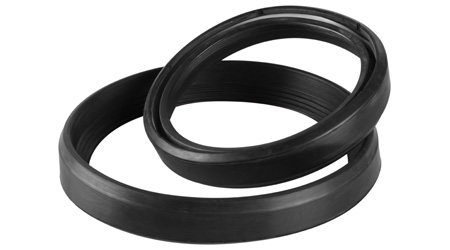In extreme sealing environments involving high pressure, high speed, and severe wear, Aramid Fabric Reinforced Seals serve as a critical defense line. By combining high-strength aramid fibers with oil-resistant rubber, these seals deliver unparalleled anti-extrusion and anti-wear performance in rotating shafts, reciprocating pistons, and valve applications. Below is an in-depth analysis of their core properties:
Core Structure: Synergy of Rigidity and Flexibility
The ”sandwich structure” (rubber matrix-reinforcement fabric-rubber matrix) enables breakthrough performance:
- High-Strength “Skeleton”: Aramid Fabric Layer
- Extrusion Resistance: Aramid fibers (e.g., Kevlar®) offer 5× the strength of steel (>3000 MPa) with 70–200 GPa modulus.
- Temperature Resistance: Continuous use at 200°C (peak 230°C), outperforming synthetic fibers.
- Self-Lubrication: Friction coefficient as low as 0.1–0.2 (steel-on-steel).
- Wear Resistance: 10× more durable than nylon, 5× better than polyester.
- Flexible “Muscle”: Rubber Matrix
- Elastic Sealing: NBR, FKM, or HNBR provides initial preload sealing.
- Media Compatibility: Customizable for fuel/acid/solvent resistance.
- Synergistic Effects
- Fabric restrains rubber extrusion; rubber protects fabric from wear.
- Dual sealing: Elastic preload + fiber barrier.
Performance Comparison Table
| Parameter | Aramid Fabric Seals | Pure Rubber Seals | Metal-Reinforced Seals |
|---|---|---|---|
| Max. Pressure | 80–100 MPa | 20–40 MPa | >100 MPa |
| Extrusion Resistance | ★★★★★ | ★★☆☆☆ | ★★★★★ |
| Wear Resistance | ★★★★☆ (Abrasive) | ★★☆☆☆ | ★★★★☆ |
| Max. Linear Speed | 20–30 m/s | ≤15 m/s | ≤5 m/s (lubricated) |
| Shock Load Adaptability | Excellent | Good | Poor (brittle) |
| Weight | Light (1.4 g/cm³) | Light | Heavy (7.8 g/cm³) |
Key Applications
- Heavy-Duty Hydraulics (>50 MPa)
- Excavator/cylinder piston seals.
- Blowout preventers (105 MPa case study, deformation <0.3 mm).
- High-Speed Rotation (>15 m/s)
- Wind turbine yaw bearings, centrifugal pump shafts (wear 1/8 vs. PTFE).
- Extreme Valves
- Power plant valves (200°C + 40 MPa).
- Coal slurry valves (abrasion resistance).
- Specialized Equipment
- Aircraft landing gear (40% lighter than metal).
Design & Maintenance
- Structure Optimization
- 45° Cross-Ply: 200% higher extrusion resistance.
- Graded Density: 4–8 layers in high-pressure zones.
- Rubber Matrix Selection
Condition Recommended Rubber Properties Fuel (>150°C) FKM Chemical resistance Lubricant (135°C) HNBR Low compression set Water-glycol EPDM Hydrolysis resistance - Failure Prevention
Failure Mode Cause Solution Delamination Rubber-fabric bond failure Use thermo-vulcanization Fiber fraying Over-compression (>30%) Limit to 15–25% Groove wear Contamination Add 80μm pre-filter
Conclusion:
Aramid fabric seals achieve the impossible through ”rigidity against pressure, flexibility against wear”:
- Withstand >80 MPa hydraulic systems.
- Operate at 30 m/s with self-lubrication.
- Extend service life 5–10× in abrasive media.
Despite costing 3–8× more than standard seals, they remain the ”ultimate line of defense” in offshore drilling, wind turbines, and heavy machinery, continually redefining pressure and speed limits.
Post time: Jul-15-2025

